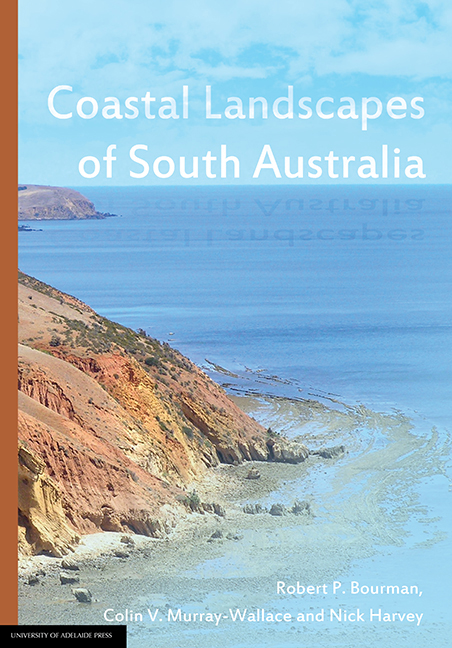Book contents
- Frontmatter
- Dedication
- Contents
- Preface
- Biographies
- Acknowledgements
- 1 Coastal landscapes of South Australia
- 2 The coast of metropolitan Adelaide
- 3 The Fleurieu Peninsula coast
- 4 The River Murray Estuary
- 5 The Coorong Coastal Plain and the Limestone Coast
- 6 The northern Gulf St Vincent tidal coastline (the Samphire Coast)
- 7 The Yorke Peninsula coastline
- 8 The northern Spencer Gulf coast
- 9 The Gulf Coast of Eyre Peninsula
- 10 The Bight Coast - West coast of Eyre Peninsula
- 11 Kangaroo Island
- 12 Explaining the coastal landscapes of South Australia - A synthesis
2 - The coast of metropolitan Adelaide
Published online by Cambridge University Press: 25 July 2017
- Frontmatter
- Dedication
- Contents
- Preface
- Biographies
- Acknowledgements
- 1 Coastal landscapes of South Australia
- 2 The coast of metropolitan Adelaide
- 3 The Fleurieu Peninsula coast
- 4 The River Murray Estuary
- 5 The Coorong Coastal Plain and the Limestone Coast
- 6 The northern Gulf St Vincent tidal coastline (the Samphire Coast)
- 7 The Yorke Peninsula coastline
- 8 The northern Spencer Gulf coast
- 9 The Gulf Coast of Eyre Peninsula
- 10 The Bight Coast - West coast of Eyre Peninsula
- 11 Kangaroo Island
- 12 Explaining the coastal landscapes of South Australia - A synthesis
Summary
Introduction
The coast of metropolitan Adelaide extends from Sellicks Beach in the south to Le Fevre Peninsula in the north (Figure 2.1). Situated in the most populated part of South Australia, the coast provides an excellent example of intense human use of coastal resources, illustrating the impact of urban development and artificial modification of the coast. A lack of understanding about coastal processes during European development has resulted in coastal degradation.
The dominant geological influence on this section of coast is a series of arcuate northeasterly trending faults (Figure 2.2), which extend from the hills and define the landward limit of the coastal plains. Differential faulting of Neoproterozoic to Cambrian strata and Paleogene and Neogene sedimentary rocks has formed the template for the metropolitan coastline. The uplifted zones are associated with prominent cliffs and headlands, while between these uplifted sections of coast, embayments occupy fault angle depressions producing sandy bays. Although important rivers such as the Onkaparinga and the Torrens have their outlets on this section of coast, they deliver minimal sediment to Gulf St Vincent. The exposure of differentially faulted rocks and sediments has provided a north-south sequence of beach compartments.
Geological setting
The geological influences on the coast of metropolitan Adelaide date back to the folded, metamorphosed and uplifted Neoproterozoic and Cambrian strata of the Adelaide Geosyncline, which broadly coincides with the modern Mount Lofty and Flinders Ranges. Through major crustal deformation events of the Delamerian Orogeny from 514 ± 3 to 490 ± 3 Ma, the region was transformed to an extensive fold mountain range of Himalayan proportions, named the Delamerides. From the Middle Ordovician (c. 470 Ma) through to earliest Permian time (299 Ma), the Delamerides were deeply eroded. The remnants of this major mountain chain influence the overall shape and character of the modern coast. Mainly during Early Permian times (299 to 290 Ma), the region experienced extensive glaciation. Evidence of this glaciation is spectacularly preserved at Hallett Cove, where the ice flow was from the south to the north with bedrock structures diverting the overall southeast-northwest movement (see Chapter Three — The Fleurieu Peninsula coast).
Erosion of the Delamerides continued for millions of years, exposing the core of the mountain range and reducing it to a planation surface of relatively low relief.
- Type
- Chapter
- Information
- Coastal Landscapes of South Australia , pp. 45 - 70Publisher: The University of Adelaide PressPrint publication year: 2016



